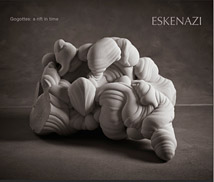Gogottes: A Rift In Time
In May 2018 David Attenborough and Tom Phillips, as naturalist and artist respectively, contributed introductions to the catalogue for the exhibition "Gogottes: a rift in time” at Eskenazi, 10 Clifford Street, London W1
These snapshots in stone in which herculean moments of fluid upheaval were suddenly solidified would each have found a proud place in a Cabinet of Curiosities. Such early precursors of the modern museum impartially gathered together natural objects and works of art. A Roman sculpture could stand next to a narwhal tusk, the latter wishfully labelled as the horn of a unicorn. Eventually the marvels of nature and art were prised apart and given separate homes.
That something might have been lost in the process is here challengingly illustrated by the showing of gogottes in the context of art. That this takes place in the gallery of the country’s leading expert on oriental antiquities reminds us however that there has been a continuum in the East of viewing reverentially selected natural fragments, of rock or fossilised wood, as objects of contemplation, customarily mounted on exquisitely fashioned bases. These are referred to as ‘Scholars’ Stones’ and continue to act as inspirational adjuncts to the desks of the philosophically inclined.
One has to return to the world of childhood, where the word ‘art’ had no currency, truly to rediscover such forms of delight. The universal pleasure of gathering pebbles on the beach does not separate nature and art. First one stone catches the eye by virtue of its curious shape, then another for its elegance until a handful of special stones indicates a standard by which one or two must be rejected and replaced, and so on, the quality ever increasing. Within a few hours the ideas of collection and connoisseurship begin to be established, later heightened by comparison with the discoveries of playmates who have developed their own aesthetic hierarchies unhampered by any such concepts as significance or abstraction.
Looking at the gigantic pebbles in this collection one can have no recourse to the usual guides of ‘who is it by?’ or ‘when was it made?’ or fish for a relevant stylistic term. One aspect of them that might tempt such categorisations is their similarity, as if they were artworks from the same hand. However they are not autonomous compositions, but fragments broken off from a single huge geological performance whose details, like sculptural tropes, echo and reecho. Entangled ropes and folds upon folds, with occasional bulges of strange symmetry, act almost musically like variations on a theme. Other striking qualities include their white unblemished surfaces at one with the marble used by great sculptors throughout the centuries. Their facture also is as if from perfect tools in an infallible hand.
Looking at them in the present we have the advantage of being at ease with abstraction. As well as admiring the convolutions of Bernini’s drapery or the interlocked figures of Laocoon we add a visual vocabulary that encompasses the non figurative work of Arp, Brancusi or Moore and even the organic architectural intricacies of Gaudi. With works that have no titles and must lack interpretative labels we are nevertheless tempted to read into them identities or scenarios as Shakespeare’s Antony does with shapeshifting clouds. Sometimes this is irresistible as with X which seen from an angle conjures up an agonised figure moving on urgently despite having to drag a cumbersome train of baggage behind him.
One in particular (x) has special resonance for me in that it uncannily replicates a sculptural epiphany of my childhood, evoking as it does with amazing exactitude a sight I witnessed many times as I watched my mother wringing out sheets from the washing tub and piling them high on the adjacent table, still wet but twisted into fantastic shapes by her strong and practised hands. Some part of me knew, even seventy or more years ago, without terms in which to think or words to describe, that this was, despite its being a humdrum domestic routine, a kind of marvel. Only now after seeing this gogotte can I fully appreciate that intertwined wonder in a family home which lacked anything which could be called art.
Each of us will have some similarly vivid reaction to this or that stone and also be struck by the fact that the gogottes on display look just as at home in an art gallery as the spectacular example (presented by Daniel Eskenazi to honour the 90th birthday of David Attenborough) does in the Natural History Museum. One quality that all of them possess is a powerful embodiment of the force of nature. Perhaps this was the meaning of Michelangelo’s ‘terribilità’ since, looking at them, we become dazzled spectators of an event happening millions of years ago, and are present at that precise moment in which, to use the words of Yeats, ‘a terrible beauty is born’.

